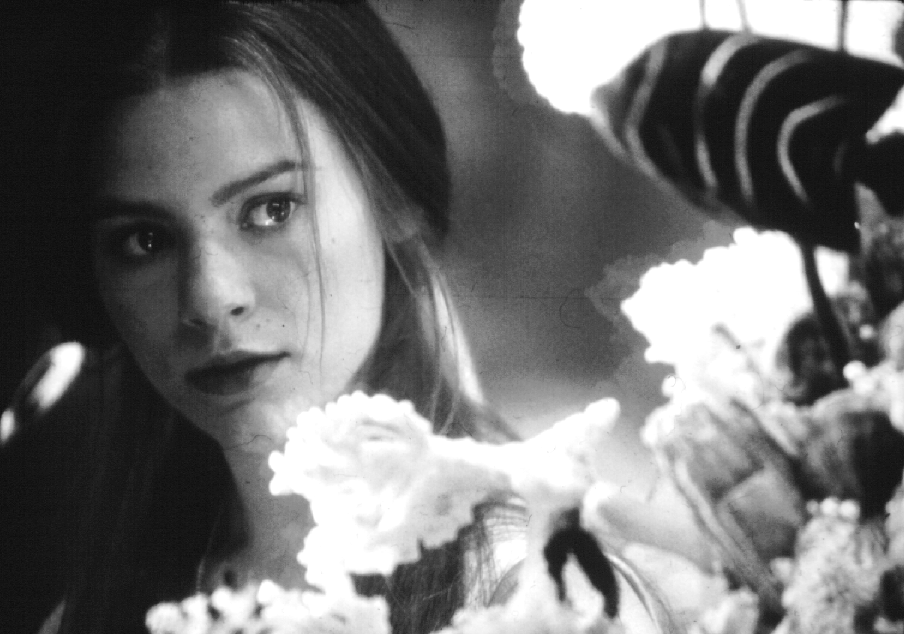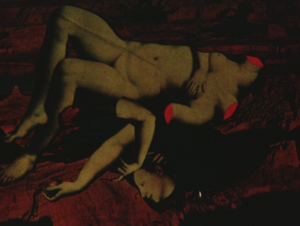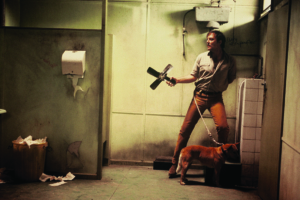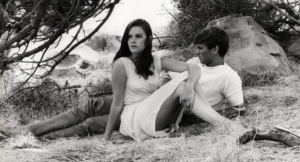Shakespeare’s Romeo and Juliet provoked in 1997 almost as much passion and violence of expression as the action of the play itself. Conservative opinion spluttered in outrage at Luhrmann’s film. While audiences responded to the latest film with considerable enthusiasm, and cinematic criticism often provided enlightening insights,[1]One of the best: Jose Arroyo, “Kiss Kiss Bang Bang”, Sight and Sound, March, 1997. It should not be forgotten, however, that the film is transgressive of Hollywood cinema tradition as well: see “AFI Conversations on Film: Jill Bilcock and Roger Savage on the Making of Baz Luhrmann’s Romeo +Juliet”, Metro, no.113/114, 1998. those who have allied themselves with Shakespeare-as-bulwark-of-tradition tended to dismiss William Shakespeare’s Romeo + Juliet as a ‘monumental disaster’[2]Mick LaSalle, “This Romeo is a True Tragedy: DiCaprio, Danes Weak in Shakespeare Update”, San Francisco Chronicle, 1996. www.sfgate.com/cgi-bin/chronicle/ a…L&directory=/chronicle/archive/1996/11/01 or a ‘violent swank-trash music video that may make you feel like reaching for the remote control’.[3]Owen Gleiberman, “Where For Art?”, Entertainment Weekly, 1996, p.1. Earnest critics decried: ‘there are “bad films”, there are “worst films of all time”, and then there’s Baz Luhrmann’s Romeo & Juliet’.[4]Luhrmann quoted in Pauline Adamek, “Romeo and Juliet”, Cinema Papers, February 1997, p.12. Amongst others: ‘manipulative fluff’ from Matthew Gold (in Book-lover’s Guide to Cinema www.panix.com/~mgold/romeo.htm). Or, Luhrmann puts ‘Shakespeare’s greatest Romance in a choke-hold and takes it slam-dancing’ from Desson Howe, Washington Post (www.washingtonpost.com/wp-srv/style/longterm/movies/videos/romeoandjuliet.htm). Roger Ebert’s damning review harks repeatedly back to Zeffirelli: ‘I think back to the tender passion of the 1968 version, and I want to shout: “Romeo! Quick! Poison yourself!”’, from Chicago Sun-Times. Mark Steyn says ‘Luhrmann has produced a splendid rock video, but the additional dialogue is superfluous to requirements … Shakespeare deserves better than to be surfed as if he were a mere Butthole.’ Mark Steyn, The Spectator, 1997, p.42. And Sheila Benson comments, ‘Luhrmann has a headful of ideas for overhauling R+J, nearly all of them dreadful … In the end, there’s nothing left but the hype and the shell of Shakespeare’. Sheila Benson “William Shakespeare’s Romeo + Juliet”, Cinemania (http://cinemania.msn.com/Movie/Review /70064/1) Another critic judges the film to be ‘little more than a long revved-up jeans ad’. See Jay Carr from The Boston Globe (www.sacbee.com/liesure themovieclub/reviews/archives/97romeo/romeo.html). The predominance of American Anglophiles amongst the collection calls for a post-colonial reading, on the relationship of the colonial exile to Metropolitan culture. One presumes, incidentally, that these critics have not seen the extraordinary Tromeo and Juliet (1997) which makes Luhrmann’s film appear positively staid. (She: ‘Parting is such sweet sorrow.’ He: ‘Totally sucks!’) Such a reaction of abhorrence is almost as interesting as the reluctance of academic publications to treat the film as a work worthy of scholarly attention.[5]The most recent Shakespeare edition of Literature/Film Quarterly gives an intelligent but brief review (vol. 25, no.2, 1997.) Shakespeare Bulletin is the only journal to have devoted serious attention to the film. Robert Kole’s thorough piece is, however, descriptive rather than analytical and Peter Newman’s reflects the understanding that Luhrmann’s film is mainly interesting for the way it speaks to ‘youth’. (Summer 1997.) The two issues of Post Script devoted to Shakespeare on film (vol.17, no. 1, Fall 1997 and vol. 17, no.2, Winter/Spring 1998) give no space to this film. I should note that my argument is qualified by the fact that Literature/Film Quarterly has accepted this article (kindly allowing Metro the right to publish first).
Before beginning a study of Shakespearean interpretations, it is important to note that the sense of definitive scripts, against which adaptations must be measured, is a product of twentieth century textual scholarship. Notions of textual purity (or Manichean notions of ‘good’ and ‘bad’ quartos) and authenticity derive from Biblical scholarship and are firmly attached to our understanding of the plays we read and perform, yet these artefacts are modernized for us and any scholarly edition will elucidate the decisions made in the collating of a series of recollections by actors and audience.[6]Graham Holderness, “Bardolatry: Or, The Cultural Materialist’s Guide to Stratford-Upon-Avon” in The Shakespeare Myth, Manchester University Press, Manchester, 1988, pp.2-15. Theoretical developments take us further: reception theory points out that any text is partly created by the reader/viewer and we generally accept that no interpretation is definitive. In the light of these points, it is intriguing to observe the critics’ ambivalence. A recent text on this subject appears open to the ‘multiple possibilities’ available in interpretations in its introduction.[7]Lynda Boose & Richard Burt, Shakespeare the Movie: Popularizing the Plays on Film, TV, and Video, Routledge, London & New York, 1997, p.3. Again, the chapter by the editors admits that a ‘single, unified Shakespeare whose works could be covered’ has always been an illusion.[8]ibid. p.18. Yet these same editors mourn, on the following page, ‘the disappearance of an older sense of the actor as someone who actually knew Shakespeare, who communed with him, understood his mind, and perhaps at times even thought that he himself was Shakespeare’.[9]ibid. p.19 Yet Sight and Sound dismisses this same nostalgic critical text with: it ‘will do nicely as a prime exhibit of pop levelling run amok’. February, 1998, pp.31-32. It seems that the author is dead, but that the author-function of Shakespeare makes for an intimidating ghost.
The action of adapting Shakespearean plays into film has mostly been dangerous for those game enough to make the attempt. The plays remain in the realm of prestige entertainment, whereas it has taken many years for film to be accepted as ‘Art’. The dominance of the visual in film can struggle with the pre-eminence of the word in Elizabethan drama. Given that it had been accepted for critics to despise theatrical productions of Shakespeare’s plays, allowing that true appreciation was only possible on the page, film was always destined to face opposition. The Bardolaters’ reluctance, or inability, to read the visual adaptation of linguistic elements of the plays leaves their comprehension of the cinematic version impoverished and the works, therefore, often despised. Translation of the play to film requires a number of stylistic decisions to be made to assist in conveying stories told often in blank verse, in archaic language and carrying the weight of an overwhelming tradition. Olivier opted for a deliberate staginess, Branagh for a stronger cinematic intertextuality in worlds distanced by time and space. Zeffirelli and Luhrmann have taken a work that is strongly familiar to one section of the audience and frighteningly off-putting to the Shakespeare-shy and ‘made it over’.
Zeffirelli’s Romeo and Juliet, revolutionary in its time, was more apparently traditional in its use of the original and so the criticism he received – for his cutting of text and youthful actors who spoke the lines ‘sagging with puppyfat’[10]John Simon, “Romeo and Juliet” in Film 68/69, 1968, p.208. and bereft of poetry – was more muted in nature. The glorious scenery of this ‘Renaissance Verona’, superb in the attempt to evoke history and the atmosphere of familiar paintings, belongs firmly in the lineage of the Victorian interpretation and production of the plays of Shakespeare.[11]See John Collick, Shakespeare, Cinema and Society, Manchester University Press, Manchester, 1989. In Zeffirelli’s film, Shakespeare’s work is directed towards a youthful audience, sexy and violent, filled with the heat and passion conveyed by the text, incorporating a critique of the adult world with its fatal thread of masculine violence. Yet it does so without betraying its ‘high art’ trappings and is less threatening to the code of respectable Shakespeare: some of the film’s actors have Shakespearean experience,[12]As do Postlethwaite and Margolyes in Luhrmann’s film, a fact which attracted relieved attention in the kinds of reviews quoted above. Given the manner in which their roles are played, I would argue that their prior experience has less impact on the high art intertextuality they might bring to a film. the period setting balances the ‘flower-child’ allusions, and the associations, mise-en-scène and music can be situated within classical cultural traditions. While it is subversive of its own culture,[13]Lord Brabourne comments that the rebelliousness expressed in the film assisted in making it one of the most successful films ever made, earning an ‘unheard-of’ 17 million dollars. See Brian McFarlane, An Autobiography of British Cinema by the Authors and Film-makers Who Made It, Methuen, London & Sydney, 1997, p. 94. this production seems more respectful towards the ‘rules’ of dealing with the Bard.
Luhrmann, on the other hand, summons an hallucinogenic range of youth and popular culture details, attempting to translate the power of Shakespeare’s story to a visually-attuned generation. Of these, only a lucky few avoid having this text murdered by classroom desiccation; others might never encounter it at all. That Luhrmann’s subversive version should be produced has aroused almost physical reactions, calling to mind Kristeva’s description of the reaction to abjection. Within the Shakespearean monotheistic economy, this film operates as ‘transgression of the Law’ or ‘sin’, that which is excluded and taboo.[14]Julia Kristeva, Powers Of Horror: An Essay On Abjection, Columbia University Press, New York & Oxford, 1982, p.17. Luhrmann presumably sees his enterprise as displaying grandeur in its amorality[15]ibid. p.4. or as a ‘crime’ ‘that flaunts its disrespect for the law – rebellious, liberating, and suicidal’, and thus not abject. It seems, however, that the critics view him as an Iago/abject: ‘immoral, sinister, scheming, and shady: a terror that dissembles, a hatred that smiles, a passion that uses the body for barter instead of inflaming it, a debtor who sells you up, a friend who stabs you’.[16]ibid. p.4. Like any crime, his film ‘draws attention to the fragility of the law’.[17]ibid. p.4. His film appears to be amongst those elements which cause abjection, that which ‘disturbs identity, system, order’. By taking and corrupting Shakespeare-as-law, Luhrmann challenges the master, who in turn must thrust him aside. It is as though the traditionalists experience the intensely physical reaction that Kristeva describes.[18]‘I experience a gagging sensation and, still farther down, spasms in the stomach, the belly; and all the organs shrivel up the body, provoke the tears and bile, increase heartbeat, cause forehead and hands to perspire.’ ibid. p.3. Why this should be so deserves some consideration.[19]Kate Chedgzoy perceives it slightly differently. On Shakespeare and abjection, she begins, ‘It is tempting to relate this evocative phrase to the massive investments of yearning and desire which cultural history has cathected on to the semi-mythical aesthetic bounty represented by the figure of Shakespeare. It precisely evokes the insatiable longing for aesthetic self-presence and plenitude which Shakespeare’s plays seem somehow more able than other texts to offer the possibility of recuperating, but nevertheless always elude.’ Kate Chedgzoy, Shakespeare’s Queer Children: Sexual Politics and Contemporary Culture, Manchester University Press, Manchester & New York, 1995, p.50.
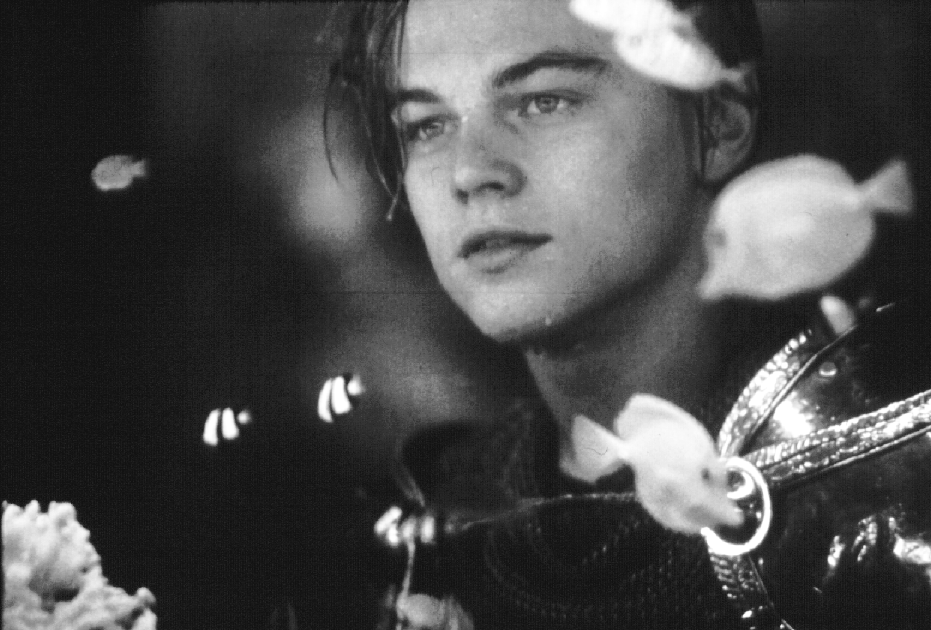
Links with the biblical tradition mentioned above point the way. As the pre-eminent figure and guardian of the British literary tradition, Shakespeare has taken on an almost god-like status and scholarly attention to his work figures as a tradition, with nearly as many defenders and attackers as the Christian churches can boast in their own history. (Or, in Bourdieu’s terms, he is ‘canonized’.) The same sense of sin applying to those who transgress the rules of religion is cast against those treating the Swan of Avon without the appropriate reverence; the Bardolaters will take no blasphemy from heretics.[20]Holderness traces the establishment of a kind of Church of Shakespeare, with the sale of ‘relics’ and pilgrim-tourists shaping the town of Stratford-Upon-Avon from the 1700s. op. cit. pp.3-15. The abject nature of sin is discovered in the sacrilegious interpretations of radicals. In theatre, the interpretation is ephemeral and raciness perhaps expected with the differing demographic involved in production and viewing. Film is trapped for the duration of its existence or reputation, reaching a wider, less cognisant, audience, and perhaps its very permanence draws out fears of irreparable devastation and rapine.
Despite the impression a reader might gather from any dismissive ‘MTV-generation trash’ review assuming that the project is committed to no more than its own ‘eye-candy’,[21]Gleiberman, op. cit. p.2. the film repays closer study. Luhrmann has given considerable attention to Shakespeare’s play and making it work within the contemporary setting. Respecting Zeffirelli’s achievement as a ‘gorgeous piece for its time’, he did not wish to traverse the same territory. He desired from the first scenes to ‘disarm our audience, many of whom thought they knew what to expect’[22]Quoted in Dean Evans, “Guns’n’Roses”, Total Film, issue 3, April 1997, p.58. and make them see the play afresh. Romeo and Juliet could not enthrall a new generation as scions of the twentieth century cultural elite; the tale must be told in a setting where its internal logic remains. This is a world that is modern and yet unfamiliar: a world where the youth might conceivably always go armed; a world where love can still be so thwarted and endangered; where the innocence and passion of the protagonists can be so out of step with the current mood. His approach is frenetic and modern, rendering the play almost immediately accessible to 1990s youth and the conflict more recognisable. His Capulets and Montagues are as violently and passionately enmeshed as the play suggests, but the trappings which here carry them into the late twentieth century have alienated that audience which finds even Branagh’s apparently safe adaptations too iconoclastic and accessible to suit its desire to keep Shakespeare the familiar property of the educated elite.
Shakespearean drama is often used to reinforce the status quo, yet the ideologies conveyed through the drama are far more diverse and conflicting than conservative critics will allow, hence the fiery debate regarding the nature of views espoused in the plays. Often the undercurrents are more transgressive than reinforcing and this movement is captured in Luhrmann’s film. Elements of Bakhtin’s carnivalesque, where established powers are called into question and the people’s culture celebrated, abound in Shakespeare’s play in the feasting, insults and ribald word-play. These are echoed in Luhrmann’s scenes at the Capulets’ party most strongly. Luhrmann wanted the feast to be somewhat sinister, he wanted ‘Romeo and Juliet and the audience to walk into a grotesque, Bacchanalian example of what their parents’ world is’.[23]Press Kit, William Shakespeare’s Romeo + Juliet, 20th Century Fox, 1996, p.12. Just as in the Bakhtinian understanding, the excesses occur in a wild and exaggerated way, filled with grotesque imagery, skewed by Romeo’s ‘acid’-addled gaze. Mercutio’s cross-dressing and the camera angles focusing up from Capulet’s groin and belly are strongly carnival elements. Zeffirelli’s feast, by comparison, is much more an ‘official feast’,[24]ibid. asserting and reinforcing a stability rejected by the family’s offspring. These elements, part of the undermining of the prestige possession of the plays, discomfort those used to an unchallenging familiarity with their Shakespeare.
For Luhrmann this familiarity is stultifying; the choice of name for his film gives an indication of his mission in approaching the complications of adaptation.[25]Luhrmann begins, however, with soundtrack elements which link him to the classical tradition. After the television on screen, dramatic orchestration from Mozart’s Symphony No.25 overlays the setting of scene. Postlethwaite’s more-or-less English accent clearly enunciates ‘star-crossed lovers’. But, as the title wipes the screen, rap music wipes the classical associations of the play’s past. He has tried to reclaim the play from its association as rarefied and stagy. Recognizing the rambunctious, sexy and violent elements to Shakespeare’s story-telling, as well as the boisterous comedy and passion, was significant for him in returning to the play’s roots. Shakespeare knew that he was providing entertainment, a fact seemingly often forgotten. Luhrmann sees the driving force behind the film as ‘addressing the original Shakespeare’, reclaiming the play from the snobbery of the Victorian inheritance in theatre and redeeming the power of the Shakespearean tale for a less hide-bound audience; the original audience did not watch it as a British classic. The chosen approach to delivery of the language, analogous to the Branagh dictum, aimed for doing ‘the words justice’ while making the impression ‘conversational’. Elizabethan language is a demanding medium for any contemporary audience; delivered in traditional versified manner, it would be an unthinkable obstacle for the youth market at which the film is pitched. The aim was to be ‘obvious, precise and clear’ and every detail in the mise-en-scène is intended to elucidate.[26]Press Kit, pp.2-3.
A ‘created world’ results: ‘a collage of modern and classic images, drawn from religion, theatre, folklore, technology and pop-culture’; varied 20th Century icons, which are intended to be overtly comprehensible. The setting, Verona Beach, equates for us Elizabethan perceptions of Verona: a hot, sexy, violent and Catholic (signifying exotic and dangerous) location.[27]ibid. p.7. While this world is recognizably modern, it is neither the future, nor the past, partly aided by being so much composed of the ‘world of the movies’.[28]Familiar elements include Rebel Without a Cause, Dirty Harry and the Busby Berkeley musicals. Press Kit, p.9. The intention was that this eclectic mix would be familiar on some level, making it easier for the audience to accept, and comprehend, the stylised language. The sets themselves were designed to convey information about the characters who moved within them in the clearest possible way, so that ‘people will know instantly where they are and will be able to concentrate on the language the actors are speaking.’[29]ibid. p.10. The girlish yet privileged innocence of Juliet’s room; the garish showiness of the ball, contrasted with the simplicity of the lovers, all work as visual shorthand.
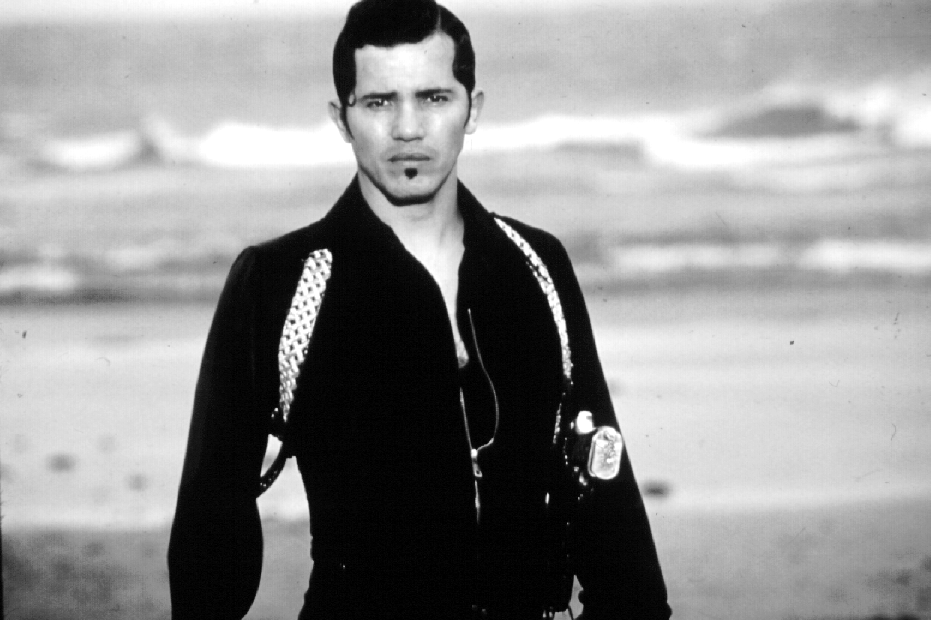
The costumes and related clues work to make the characters swifter to comprehend, to detract as little as possible from the attention necessary to understanding the dialogue. Drawing on characters recognisable from the film tradition was part of this. Gloria Capulet (Diane Venora) is a ‘Southern Belle’ and the elements of ’50s design to her clothing comment on the nature of her role in her marriage. Romeo’s (Leonardo DiCaprio) and Juliet’s (Claire Danes) costuming favours blues, silvers and whites, remarkable for simplicity. In a way they are like ‘specters, the ones whose hold on life is the most tenuous’ and this sense of tenuousness is augmented by the degree to which the camera dwells on the gawky and often wounded vulnerability of Romeo. Other examples of succinct use of mise-en-scène in characterisation are evident in the ball scenes. Tybalt (John Leguizamo), for example, with all his Marian tokens, has more than a little of the devil to him, not only in the styling of his hair and moustache, but also in his choice of Mephistophelean masque costume. His gun-play is as exotically skilled as Mercutio suggests the original’s sword-play to have been; links to the Western film are playfully suggested by musical accompaniment as well as posturing, not to mention the extreme focus on the grinding out of his cigarette. Old Capulet (Paul Sorvino) is a Mafia boss and is robed as a Caesar in his riot of excess. And Paris (Paul Rudd) is characterised by his appearance as that all-American, clean-cut hero of the modern age – the Astronaut. Everything is about ‘revealing the language, making it less distant and more potent’[30]ibid. p.15. for its intended audience.
Another element to the mise-en-scène working to overcome the dangers of disjunction lies in the careful attention to justifying anachronistic allusions, as evidenced by touches such as the guns labelled ‘Rapier 9mm’. The sycamore grove, for example, not actually visited in the play, provides the setting for much of the jostling for power and prestige amongst the gangs of young men in this version. It has become ‘Sycamore Grove’, a shabby, almost post-holocaust wreck of an amusement-park. The wording figures over the remnants of a proscenium arch, the tincture of a dilapidated staginess which informs both Romeo’s pining and Mercutio’s death (itself further dramatised by the fortuitous arrival of a hurricane).
Disrespectful elements to disturb the establishment include a number of visual Shakespearean jokes, including one played at the expense of the revered Globe Theatre, now a seedy pool hall. Also pilloried is religion, which plays a constant and clashing role in this mise-en-scène. The cathedral dominates the landscape and the montages establishing this city, itself dominated by the giant statues of Mary and Jesus. This society permeated by violence, drugs, adultery and revenge is undoubtedly Catholic and matches Shakespeare’s Verona (not to mention Protestant England) for hypocrisy in the duty paid to this faith. All have lost the ‘pious underpinnings’ to this overt religious display.[31]ibid. p.15. But the surreal element continues. This is a Catholicism unrecognisable to the contemporary adherent: neon-lit crosses; choral versions of ‘Prince’ songs accompanying the mass; a priest with tattoos, Hawaiian shirts and sinister relationships with his young charges.[32]This last element may sadly be more recognisable.
Nor is William Shakespeare’s Romeo + Juliet filmed in the traditional ‘continuity’ style of editing, which seeks to efface the existence of the camera as mediator of the narrative experience. The camera-work and editing again undermine any pretence towards realism that the unwary viewer might be tempted to read. The screenplay is full of the camera ‘slamming’ in and out and Luhrmann has his editor fast-forwarding (anxious, like Zeffirelli, to maintain pace)[33]Robert Hapgood, “Popularizing Shakespeare: The Artistry of Franco Zeffirelli” in Boose & Burt, op. cit. p.82. through bridging sequences with dizzying editing of montages building the overview of the city as well as establishing the edgy and vertiginous atmosphere of this town where the work of seconds can radically alter one’s fate. In contrast to this frenetic pace, Romeo and Juliet are surrounded by moments of stillness and some of the longest unmoving takes of the film are in the extreme close-ups of their faces creating a ‘sweet counterpoint to the chaos’.[34]Ryan Gilbey, “William Shakespeare’s Romeo + Juliet”, Premiere, April, 1997, p.7. The recurrent water imagery usually reflects this sense of peace. The cinematographer, Donald McAlpine, aimed to remove every vestige of ‘stage’, every hint of highbrow ‘classic’ by trying ‘to develop as much movement and change of perspective as possible, every cinematic trick we [could] think of to make it look as much like a movie as we [could].’[35]McAlpine adds that the interplay of a ‘down, hard style’ and ‘lyrical language’ augment the contrast between the lovers and their world, in a ‘broad anamorphic format’ which creates the cinematic feel. Anamorphic: gives ‘space on the screen to encompass two people talking to each other, while providing room for background detail.’ Press Kit, pp.16-17. The camera-work furthers the sense of transgression: stability and perpetuation are reinforced by the classic Hollywood ‘continuity editing’ that ‘serves to suture up the gaps, potential fissures in the unity of the diegesis’.[36]Bill Nichols, Ideology and the Image, Indiana University Press, Bloomington, 1981,
p.83. By failing to mask these to ensure the film process remains hidden, a film challenges our desire to suspend disbelief and succumb to the inevitable rightness of the status quo.
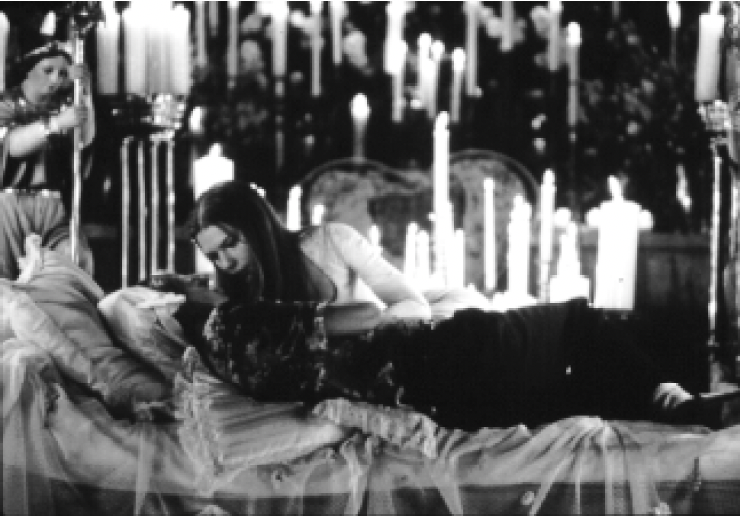
The first and last moments of this production indicate starkly that this is not a realist text. The chorus’s words are spoken from the television that moves in on the black screen from the distance (filling or replacing the cinema screen?)[37]Thanks to Ass. Prof. Brian McFarlane for this idea. and finally diminishes out of it. The awareness of itself as construct urged regularly by editing and mise-en-scène (not to mention by its overtly made-for-album musical soundtrack) is signalled from the first moment. This becomes even more apparent when the film is viewed on video, with a television screen growing to full size within another television screen. This is not merely included as a distancing device, however – for Luhrmann ‘television is the chorus of our lives’.[38]Adamek, op. cit. p.14.
Both Zeffirelli and Luhrmann transgressed in the direction of their balcony scenes. It was the tradition that this was the moment for the poetry to dominate and that the lovers never touched. A decade before Zeffirelli’s film the Castellani version, with Susan Shentall and Laurence Harvey, presents the ever-parodied placement of plum-mouthed wooer below and winsome virgin above, never touching, ever yearning; this traditional theatrical enunciation and formalised gesture was the norm. The 1968 and 1996 versions’ degree of transgression highlights the break made and also the differences between the two films; both have excised some of the poetry, but it was in the ‘stage-business’ that they shocked. Zeffirelli allows his Romeo and Juliet to touch and kiss, adding a pungent eroticism to the wordy sonnet-shaped wooing, perhaps too, adding to the plausibility that they should choose to wed by the end of the scene.
Luhrmann, in his attempt to make this excessively familiar scene completely new, has much of it conducted within the Capulets’ swimming pool, his Romeo and Juliet entwined. The scene is framed by humour: the tradition is parodied as Romeo stares longingly at the balcony at the light breaking through yonder window, but the Nurse (Miriam Margolyes) appears, provoking shocked laughter and renewed attention. The conclusion offers the Nurse’s silhouette waggling in frustration behind that same window. Tension, however, is not sacrificed. It mounts as images of the lovers are intercut with the surveillance by guards and nurse – both remind us of the perilousness of the meeting. Romeo enters a darkened, traditional setting to have it flooded with the gaudy glow of Christmas lights. A classical statue of a youth resembling Romeo points to the prestige associations of the play, DiCaprio’s coltish clumsiness contrasting with its static grace. Juliet then appears at ground level from a surprising elevator; a scream and the splash of the pair tumbling into the pool end the worst disruptions to the spectators’ desire to immerse themselves in the lovers’ exchange.
The aqueous embraces serve a similar purpose to Zeffirelli’s, creating the bond between the lovers. The stillness of the camera, the prolonged and close focus on their faces, enshrining their individual passion and intense eye-contact, convey Romeo and Juliet’s swift-growing intimacy. The images further illustrate the couple’s abstraction from their society. The shimmering of this unearthly blue light as it reflects upon their faces suggests incorporeality, a ghostly fragility; their movement is a dance of such slowness and delicacy that it melts the memory of the earlier ball. Finally, Juliet mounts the stairs to the balcony scenes, recreating her as the traditional Juliet and forming a visual echo of Zeffirelli’s version. This is not travesty, but renewal.
The possessiveness expressed in the appalled reactions of devastated Anglophiles towards this film is intriguing. The idea that Zeffirelli’s adaptation, which spoke so powerfully to its own contemporaries, signalling its significance for the peaceniks and free love generation, ought to be the last word on the matter is extraordinary. As most recognize, no interpretation is definitive. Luhrmann has merely taken up the challenge which Shakespeare’s work continues to pose of reworking and revising to keep it fresh. It is worth recalling that ‘Shakespeare’s work was popular culture when it was produced’.[39]Marjorie Garber interviewed in Hannah Feldman, “Some Like It Haute”, World Art #1/95, p.30. These directors adopt very different cinematographic techniques to smooth the contrast between the visual and the language; Branagh has commented: ‘We see something in the latest Romeo and Juliet that is utterly different and radical and quite dazzling in its way, and yet the more traditional version of Zeffirelli is also a very fine film. They’re polar opposites, but the writing, the work and the feeling in the play is still there’.[40]Quoted in Peter Sinden, “Do the Bard, Man!”, Film Review, March, 1997, p.55. Both interpretations are valid and stimulating; they should be able to live alongside the passionate actor with nothing but bare boards to support his incarnation of the poetry.[41]See Harry Eyres, “Shakespeare: Do We Need Him?”, The Spectator, 24th May, 1997, p.30. The cinematic and theatrical arts can both explore the play in the ways best suited to their own strengths. This never needed to be a war.
Endnotes
| 1 | One of the best: Jose Arroyo, “Kiss Kiss Bang Bang”, Sight and Sound, March, 1997. It should not be forgotten, however, that the film is transgressive of Hollywood cinema tradition as well: see “AFI Conversations on Film: Jill Bilcock and Roger Savage on the Making of Baz Luhrmann’s Romeo +Juliet”, Metro, no.113/114, 1998. |
|---|---|
| 2 | Mick LaSalle, “This Romeo is a True Tragedy: DiCaprio, Danes Weak in Shakespeare Update”, San Francisco Chronicle, 1996. www.sfgate.com/cgi-bin/chronicle/ a…L&directory=/chronicle/archive/1996/11/01 |
| 3 | Owen Gleiberman, “Where For Art?”, Entertainment Weekly, 1996, p.1. |
| 4 | Luhrmann quoted in Pauline Adamek, “Romeo and Juliet”, Cinema Papers, February 1997, p.12. Amongst others: ‘manipulative fluff’ from Matthew Gold (in Book-lover’s Guide to Cinema www.panix.com/~mgold/romeo.htm). Or, Luhrmann puts ‘Shakespeare’s greatest Romance in a choke-hold and takes it slam-dancing’ from Desson Howe, Washington Post (www.washingtonpost.com/wp-srv/style/longterm/movies/videos/romeoandjuliet.htm). Roger Ebert’s damning review harks repeatedly back to Zeffirelli: ‘I think back to the tender passion of the 1968 version, and I want to shout: “Romeo! Quick! Poison yourself!”’, from Chicago Sun-Times. Mark Steyn says ‘Luhrmann has produced a splendid rock video, but the additional dialogue is superfluous to requirements … Shakespeare deserves better than to be surfed as if he were a mere Butthole.’ Mark Steyn, The Spectator, 1997, p.42. And Sheila Benson comments, ‘Luhrmann has a headful of ideas for overhauling R+J, nearly all of them dreadful … In the end, there’s nothing left but the hype and the shell of Shakespeare’. Sheila Benson “William Shakespeare’s Romeo + Juliet”, Cinemania (http://cinemania.msn.com/Movie/Review /70064/1) Another critic judges the film to be ‘little more than a long revved-up jeans ad’. See Jay Carr from The Boston Globe (www.sacbee.com/liesure themovieclub/reviews/archives/97romeo/romeo.html). The predominance of American Anglophiles amongst the collection calls for a post-colonial reading, on the relationship of the colonial exile to Metropolitan culture. One presumes, incidentally, that these critics have not seen the extraordinary Tromeo and Juliet (1997) which makes Luhrmann’s film appear positively staid. (She: ‘Parting is such sweet sorrow.’ He: ‘Totally sucks!’) |
| 5 | The most recent Shakespeare edition of Literature/Film Quarterly gives an intelligent but brief review (vol. 25, no.2, 1997.) Shakespeare Bulletin is the only journal to have devoted serious attention to the film. Robert Kole’s thorough piece is, however, descriptive rather than analytical and Peter Newman’s reflects the understanding that Luhrmann’s film is mainly interesting for the way it speaks to ‘youth’. (Summer 1997.) The two issues of Post Script devoted to Shakespeare on film (vol.17, no. 1, Fall 1997 and vol. 17, no.2, Winter/Spring 1998) give no space to this film. I should note that my argument is qualified by the fact that Literature/Film Quarterly has accepted this article (kindly allowing Metro the right to publish first). |
| 6 | Graham Holderness, “Bardolatry: Or, The Cultural Materialist’s Guide to Stratford-Upon-Avon” in The Shakespeare Myth, Manchester University Press, Manchester, 1988, pp.2-15. |
| 7 | Lynda Boose & Richard Burt, Shakespeare the Movie: Popularizing the Plays on Film, TV, and Video, Routledge, London & New York, 1997, p.3. |
| 8 | ibid. p.18. |
| 9 | ibid. p.19 Yet Sight and Sound dismisses this same nostalgic critical text with: it ‘will do nicely as a prime exhibit of pop levelling run amok’. February, 1998, pp.31-32. |
| 10 | John Simon, “Romeo and Juliet” in Film 68/69, 1968, p.208. |
| 11 | See John Collick, Shakespeare, Cinema and Society, Manchester University Press, Manchester, 1989. |
| 12 | As do Postlethwaite and Margolyes in Luhrmann’s film, a fact which attracted relieved attention in the kinds of reviews quoted above. Given the manner in which their roles are played, I would argue that their prior experience has less impact on the high art intertextuality they might bring to a film. |
| 13 | Lord Brabourne comments that the rebelliousness expressed in the film assisted in making it one of the most successful films ever made, earning an ‘unheard-of’ 17 million dollars. See Brian McFarlane, An Autobiography of British Cinema by the Authors and Film-makers Who Made It, Methuen, London & Sydney, 1997, p. 94. |
| 14 | Julia Kristeva, Powers Of Horror: An Essay On Abjection, Columbia University Press, New York & Oxford, 1982, p.17. |
| 15 | ibid. p.4. |
| 16 | ibid. p.4. |
| 17 | ibid. p.4. |
| 18 | ‘I experience a gagging sensation and, still farther down, spasms in the stomach, the belly; and all the organs shrivel up the body, provoke the tears and bile, increase heartbeat, cause forehead and hands to perspire.’ ibid. p.3. |
| 19 | Kate Chedgzoy perceives it slightly differently. On Shakespeare and abjection, she begins, ‘It is tempting to relate this evocative phrase to the massive investments of yearning and desire which cultural history has cathected on to the semi-mythical aesthetic bounty represented by the figure of Shakespeare. It precisely evokes the insatiable longing for aesthetic self-presence and plenitude which Shakespeare’s plays seem somehow more able than other texts to offer the possibility of recuperating, but nevertheless always elude.’ Kate Chedgzoy, Shakespeare’s Queer Children: Sexual Politics and Contemporary Culture, Manchester University Press, Manchester & New York, 1995, p.50. |
| 20 | Holderness traces the establishment of a kind of Church of Shakespeare, with the sale of ‘relics’ and pilgrim-tourists shaping the town of Stratford-Upon-Avon from the 1700s. op. cit. pp.3-15. |
| 21 | Gleiberman, op. cit. p.2. |
| 22 | Quoted in Dean Evans, “Guns’n’Roses”, Total Film, issue 3, April 1997, p.58. |
| 23 | Press Kit, William Shakespeare’s Romeo + Juliet, 20th Century Fox, 1996, p.12. |
| 24 | ibid. |
| 25 | Luhrmann begins, however, with soundtrack elements which link him to the classical tradition. After the television on screen, dramatic orchestration from Mozart’s Symphony No.25 overlays the setting of scene. Postlethwaite’s more-or-less English accent clearly enunciates ‘star-crossed lovers’. But, as the title wipes the screen, rap music wipes the classical associations of the play’s past. |
| 26 | Press Kit, pp.2-3. |
| 27 | ibid. p.7. |
| 28 | Familiar elements include Rebel Without a Cause, Dirty Harry and the Busby Berkeley musicals. Press Kit, p.9. |
| 29 | ibid. p.10. |
| 30 | ibid. p.15. |
| 31 | ibid. p.15. |
| 32 | This last element may sadly be more recognisable. |
| 33 | Robert Hapgood, “Popularizing Shakespeare: The Artistry of Franco Zeffirelli” in Boose & Burt, op. cit. p.82. |
| 34 | Ryan Gilbey, “William Shakespeare’s Romeo + Juliet”, Premiere, April, 1997, p.7. |
| 35 | McAlpine adds that the interplay of a ‘down, hard style’ and ‘lyrical language’ augment the contrast between the lovers and their world, in a ‘broad anamorphic format’ which creates the cinematic feel. Anamorphic: gives ‘space on the screen to encompass two people talking to each other, while providing room for background detail.’ Press Kit, pp.16-17. |
| 36 | Bill Nichols, Ideology and the Image, Indiana University Press, Bloomington, 1981, p.83. |
| 37 | Thanks to Ass. Prof. Brian McFarlane for this idea. |
| 38 | Adamek, op. cit. p.14. |
| 39 | Marjorie Garber interviewed in Hannah Feldman, “Some Like It Haute”, World Art #1/95, p.30. |
| 40 | Quoted in Peter Sinden, “Do the Bard, Man!”, Film Review, March, 1997, p.55. |
| 41 | See Harry Eyres, “Shakespeare: Do We Need Him?”, The Spectator, 24th May, 1997, p.30. |
